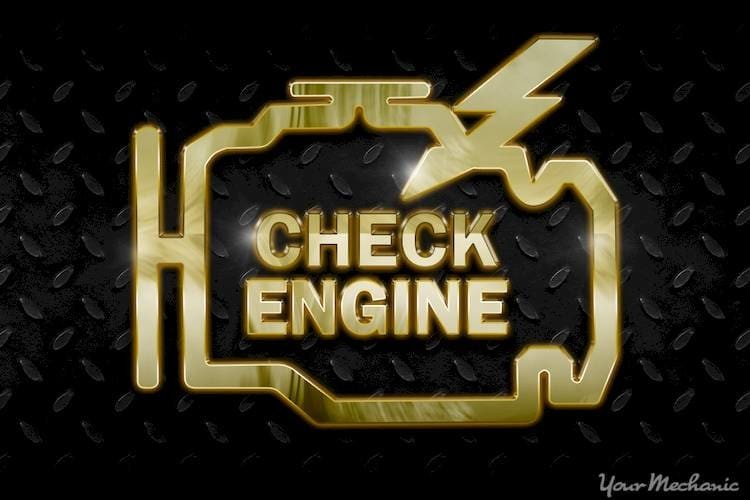The OBDII error code P0023 is a common diagnostic trouble code that automotive technicians and enthusiasts may encounter. This code, specifically “Camshaft Position B – Actuator Circuit (Bank 2)”, indicates a potential issue within the engine’s variable valve timing (VVT) system. Understanding the intricacies of P0023 is crucial for accurate diagnosis and effective repair.
 Check engine light illuminated on a car dashboard. This light can indicate OBDII error code P0023, signaling a problem with the Bank 2 camshaft actuator circuit.
Check engine light illuminated on a car dashboard. This light can indicate OBDII error code P0023, signaling a problem with the Bank 2 camshaft actuator circuit.
Decoding the P0023 Error Code
At its core, the P0023 code signals that the Engine Control Module (ECM) has detected an electrical circuit malfunction in the Oil Control Valve (OCV) responsible for the Bank 2 exhaust camshaft. The ECM monitors the OCV’s performance, and P0023 is triggered when the ECM perceives an open or short circuit within this system during a drive cycle.
To further clarify the definition:
- Camshaft Position B: Refers to the exhaust camshaft. ‘A’ typically denotes the intake camshaft, and ‘B’ the exhaust.
- Actuator Circuit: Points to the electrical circuit controlling the Oil Control Valve (OCV), which is the actuator in this VVT system.
- Bank 2: Indicates the side of the engine opposite to Bank 1. Bank 1 is generally the side containing cylinder number 1.
Common Causes of a P0023 Code
Several factors can lead to the triggering of a P0023 error code. Pinpointing the exact cause is vital for efficient repair. The common culprits include:
- Oil Control Valve (OCV) Malfunction: The OCV itself might be faulty. This could involve internal shorts, open circuits within the valve solenoid, or mechanical failure preventing proper valve operation.
- OCV Circuit Issues: Problems within the electrical wiring or connectors leading to the Bank 2 exhaust camshaft OCV are frequent causes. This can include:
- Short circuits: Wires may be shorted to ground or to each other, disrupting the intended electrical flow.
- Open circuits: Breaks or disconnections in the wiring can prevent the electrical signal from reaching the OCV.
- Corrosion: Corrosion within the OCV connector or wiring harness can increase resistance and lead to circuit malfunctions.
- ECM Issues (Less Common): While less frequent, a fault within the ECM itself could lead to misdiagnosis of the OCV circuit. This is typically considered after ruling out other potential causes.
Symptoms Associated with P0023
The symptoms of a P0023 code can vary in severity depending on the nature of the fault and the vehicle’s specific engine management system. Common symptoms include:
- Check Engine Light Illumination: This is the most immediate and universal symptom. The malfunction indicator lamp (MIL) will illuminate to alert the driver of a detected issue.
- Hesitation During Acceleration: If the camshaft timing is not properly controlled due to OCV issues, the engine may experience hesitation or a lack of power during acceleration.
- Hard Starting: In cases where the OCV is shorted, it can disrupt the engine’s starting sequence, leading to hard start conditions.
- Reduced Fuel Economy: Improper camshaft timing can negatively impact fuel combustion efficiency, resulting in decreased fuel mileage.
- Rough Idle or Stalling: Depending on the camshaft timing position and the nature of the OCV fault, the engine may exhibit a rough idle, misfires, or even stall, particularly during deceleration.
It’s important to note that symptom severity can fluctuate based on the specific timing position of the camshaft when the fault occurs.
Diagnosing the P0023 Code: A Step-by-Step Approach
A systematic diagnostic approach is essential for accurately identifying the root cause of a P0023 code. Mechanics typically follow these steps:
- Visual Inspection: Begin with a thorough visual inspection of the OCV and its wiring. Check for any obvious signs of damage, such as frayed wires, corroded connectors, or oil leaks around the OCV.
- Code Scan and Freeze Frame Data: Use an OBDII scanner to confirm the P0023 code and retrieve any freeze frame data. Freeze frame data provides a snapshot of engine parameters at the moment the code was triggered, which can be helpful for diagnosis.
- Code Clearing and Retest: Clear the P0023 code and perform a test drive to see if the code reappears. This helps confirm if the fault is intermittent or persistent.
- OCV Resistance Test: Use a multimeter to measure the resistance of the OCV solenoid. Compare the reading to the manufacturer’s specifications to check for internal shorts or open circuits within the valve.
- Wiring Circuit Testing: Test the wiring between the ECM and the OCV for continuity, shorts to ground, and shorts to voltage. This can pinpoint wiring harness issues.
- Manufacturer-Specific Pinpoint Tests: Consult the vehicle’s service manual for manufacturer-specific pinpoint tests related to the P0023 code. These tests often provide detailed procedures and expected values for specific engine types.
Caution: Always adhere to manufacturer-recommended testing procedures. Incorrect testing can potentially lead to further engine damage.
Common Diagnostic Mistakes to Avoid
To ensure accurate diagnosis and prevent unnecessary repairs, mechanics should be mindful of these common mistakes:
- Ignoring Basic Checks: Before diving into complex tests, always check the engine oil level, condition, and viscosity. Low or contaminated oil can affect VVT system performance.
- Skipping Code Verification: Always verify that the P0023 code returns after clearing it before proceeding with extensive diagnostics.
- Not Following Pinpoint Tests: Manufacturer-specific pinpoint tests are designed for accurate diagnosis. Deviating from these procedures can lead to misdiagnosis.
- Replacing Components Without Proper Testing: Avoid replacing parts like the OCV or ECM without conclusive test results indicating they are faulty.
Severity of the P0023 Code
The P0023 code should be considered a moderately serious issue. While it may not immediately render the vehicle undrivable, neglecting it can lead to:
- Engine Performance Issues: Rough running, stalling, and hesitation can worsen over time.
- Reduced Fuel Efficiency: Continued operation with incorrect camshaft timing will lead to ongoing fuel economy losses.
- Carbon Fouling: Inefficient combustion can contribute to carbon buildup in the engine, particularly on valves.
- ECM Damage (in prolonged short circuit cases): In rare cases, a persistent short circuit in the OCV circuit could potentially damage the ECM.
Repair Solutions for P0023
The repairs needed to resolve a P0023 code depend on the underlying cause identified during diagnosis. Common repair solutions include:
- Wiring Repair or Replacement: Repairing or replacing damaged wiring or connectors in the OCV circuit is often necessary. This may involve fixing shorts, open circuits, or corroded terminals.
- OCV Replacement: If testing confirms that the Oil Control Valve itself is faulty, replacement of the OCV is required.
- ECM Replacement (Rare): In very rare cases, if the ECM is diagnosed as the source of the problem, ECM replacement and reprogramming may be necessary.
Additional Considerations
Corrosion within the OCV connector is a frequently encountered issue that can mimic an open circuit and trigger a P0023 code. Thorough inspection and cleaning of connectors are crucial steps in the diagnostic process. Similarly, ensure the wiring harness is carefully inspected for any breaks or shorts along its entire length.
For expert assistance with a P0023 code, consult a certified mechanic. They possess the specialized tools and knowledge to accurately diagnose and repair VVT system issues.


